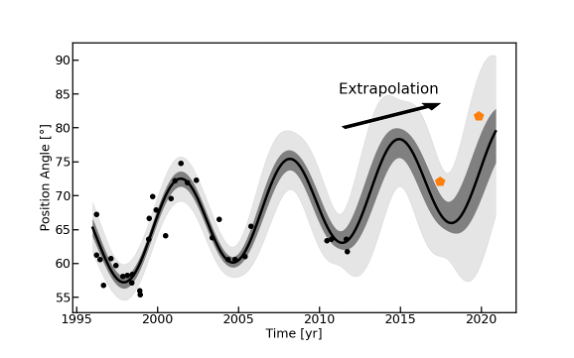
Radio jet precession in M81*
by Sebastiano von Fellenberg

The galaxy M81 is located at a distance of 3.36 ± 0.34 Mpc (Freedman et al. 1994) and its black hole (M81*) belongs to the class of the low-luminosity AGN (LLAGN), as such exhibits relatively weak (intrinsic) radio emission (e.g., Brunthaler et al. (2006)). However, it is the closest LLAGN to Earth and as such has a high apparent luminosity. It can therefore serve as a test-bed to characterize this class of accreting black holes (Markoff et al. 2008). As such it may be the best candidate to bridge the accretion processes between Sgr A* and other LLAGN (GRAVITY Collaboration et al. 2020). In contrast to Sgr A*, the radio emission of M81* is extended in a detectable jet, which has been well classified by numerous VLBI observations carried out by the EVN and the VLBA (e.g.,Brunthaler 2001). One key finding of these VLBI observations was that its jet is extended in the north-east direction of the sky. Through multi-year observations, Martí-Vidal et al. (2011) found that the jet position angle changes as a function of time. They suggested that this change might show a seven year periodicity. Their model therefore makes a testable prediction on the evolution of the jet, which we test with EVN and VLBA observations in 2017, 2018, and 2019. For the calibration of the VLBI data, we have made use of the novel rPICARD calibration pipeline (Janssen et al., 2019), which makes use of the CASA VLBI functionalities (van Bemmel et al. 2022).
Our data confirms a precession period of ∼ 7 yr on top of a small linear drift. We further show that two 8 GHz observations are consistent with a precession period of ~7 yr, but show a different time-lag w.r.t. to the 5 GHz and 1.7 GHz observations. We do not find a periodic modulation of the light curve with the jet precession, and therefore rule out a Doppler nature of a historic 1998-2002 flare. Our observations are consistent with either a binary black hole origin of the precession or precession caused by the Lense-Thirring effect.
Published in https://ui.adsabs.harvard.edu/abs/2023A%26A...672L...5V/abstract